For American women, job opportunities look much different than they did 50 years ago. Women have made gains in labor force participation and wages, and they’ve increased their presence in the highest-paying jobs. Some of that progress has stalled in recent years, however, and large gender gaps persist at the top levels of government and business leadership.
Ahead of Women’s History Month, here’s a look at some of these trends and data points, based on Pew Research Center surveys and analyses as well as federal data.
Pew Research Center conducted this analysis ahead of Women’s History Month to better understand the gains women have experienced and the gaps that persist in the U.S. labor force, including in top government and business leadership positions.
Labor force data comes from the Bureau of Labor Statistics and the Census Bureau’s Current Population Survey. The civilian labor force includes those who are either employed or actively looking for work.
More information about the Center analyses and surveys, including their methodologies, can be found at the links in the text.
Women made up 47% of the U.S. civilian labor force in 2023, up from 30% in 1950 – but growth has stagnated, Bureau of Labor Statistics (BLS) data shows. The share of women in the labor force generally grew throughout the second half of the 20th century but has since leveled off.
The BLS projects that women will continue to make up slightly less than half of the labor force through 2032.
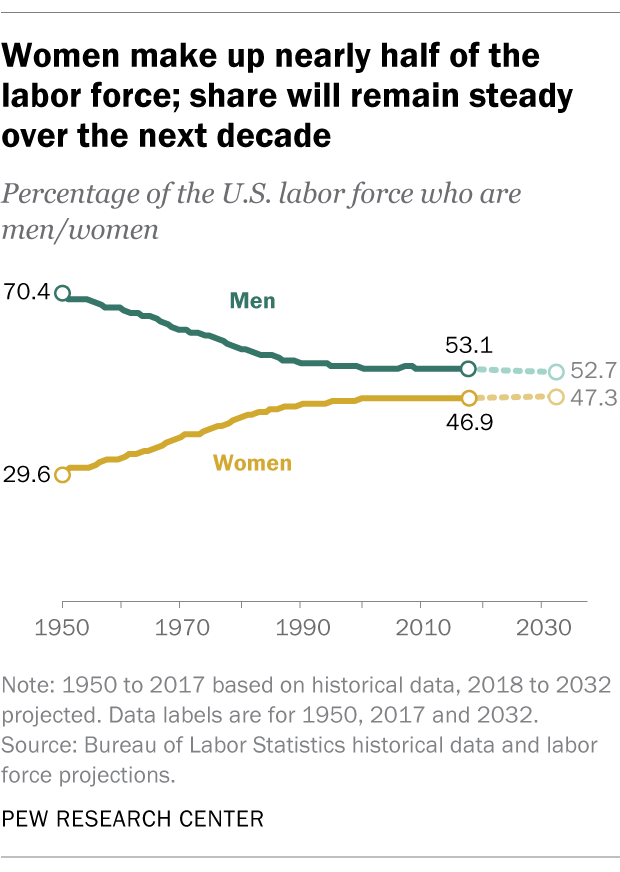
Women outnumber men in the U.S. college-educated workforce, now making up 51% of those ages 25 and older, according to Current Population Survey data from the fourth quarter of 2023. Women first surpassed men in the college-educated labor force in the fourth quarter of 2019. They remained more than half of this group through the COVID-19 pandemic, which resulted in a sharp recession and an overall decline in the size of the nation’s labor force.
The gender shift in the college-educated labor force happened about four decades after women overtook men in the number of adults earning a bachelor’s degree each year.
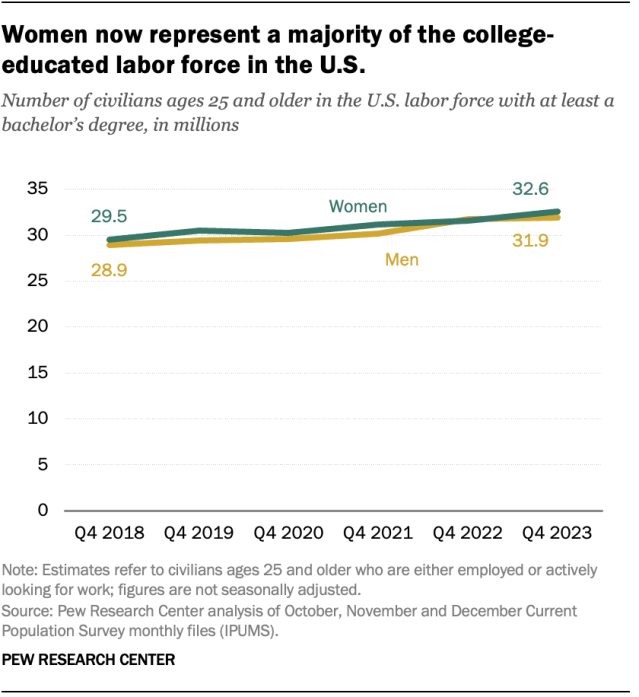
About a third of workers in the country’s 10 highest-paying occupations (35%) are women – up from 13% in 1980, a November 2023 analysis of Census Bureau data shows. Women have increased their presence in almost all of these high-paying jobs. Workers in these occupations typically earn more than $100,000 a year and include physicians, lawyers and dentists.
Despite these gains, women are still the minority in nine of these jobs. Pharmacists are the exception: 61% are women. The share of women in the other nine occupations remains well below their share in the U.S. workforce overall.
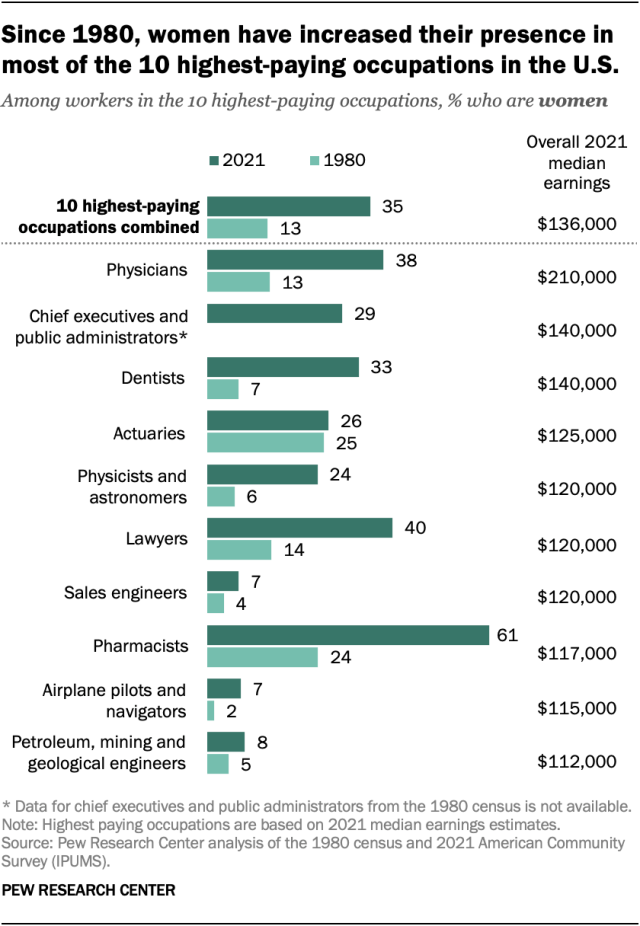
The share of women in opposite-sex marriages who earn as much as or more than their husband has roughly tripled over the past 50 years, according to a spring 2023 analysis of Census Bureau data. In 2022, women were the sole or primary breadwinner in 16% of opposite-sex marriages, up from 5% in 1972. Husbands and wives are roughly equal contributors in 29% of marriages today, compared with 11% in 1972.
Looked at another way, husbands were the breadwinner in 85% of marriages 50 years ago. That has dropped to 55% of marriages today.
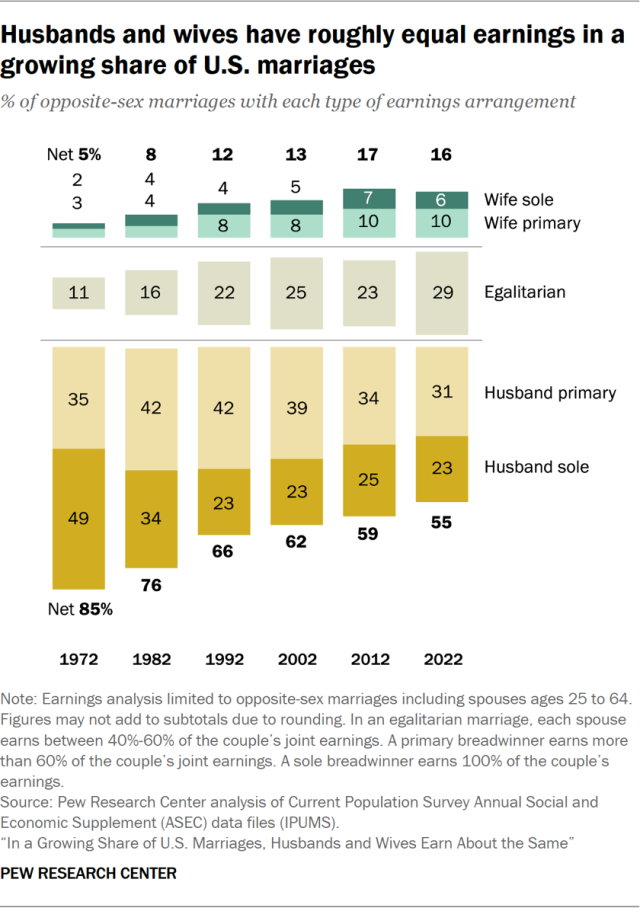
The gender pay gap – the difference between the median earnings of men and women – has remained relatively flat in the United States over the past two decades, according to an analysis of hourly earnings of full- and part-time workers. In 2022, U.S. women typically earned 82 cents for every dollar men earned. That was about the same as in 2002, when women earned 80 cents to the dollar.
When asked about the factors that may play a role in the gender wage gap, half of U.S. adults point to employers treating women differently as a major reason, an October 2022 survey shows. Smaller shares point to women making different choices about how to balance work and family (42%) and working in jobs that pay less (34%).
Women are much more likely than men (61% vs. 37%) to say a major reason for the gap is that employers treat women differently.
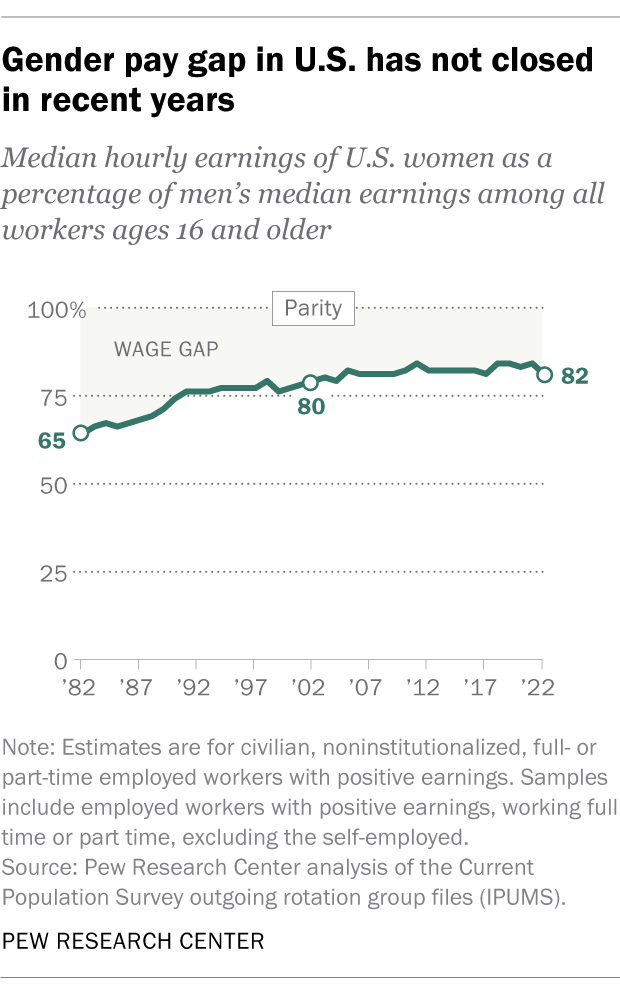
Women still lag in top leadership positions in business and government. Women have made inroads in a wide range of leadership positions in recent decades, but have not reached parity with their male counterparts in most cases. As of September 2023:
- Federal and state legislators: 28% of U.S. congressional members and about a third of state legislators are women.
- Governors: 8 Democratic and four Republican women serve as governors.
- Presidential Cabinet: President Joe Biden’s Cabinet is a rare example of gender parity in government leadership. Of 25 Cabinet or Cabinet-level positions, 12 are held by women (48%).
- Executive business leadership: 11% of Fortune 500 company CEOs are women, along with 30% of Fortune 500 board members.
Slim majorities of Americans say there are too few women in top political offices and executive business positions, a July 2023 survey shows. When it comes to the number of women elected to political office, 53% of adults say there are too few, 8% say there are too many, and 37% say it is about right. Views of women in business leadership are similar: 55% of adults say there are too few women in these roles, 6% say there are too many, and 37% say there are about the right number.
In both cases, Americans cite the same top reasons why there are fewer women than men in these roles: that women have to do more to prove themselves than men, and that women in each field face gender discrimination.
The public is divided over whether being a woman makes it more difficult to get ahead, according to an April 2023 survey. Half of Americans say that being a woman hurts a person’s ability to get ahead in the U.S., while 24% say it helps, and 25% say it neither helps nor hurts.
Women are more likely than men to say being a woman hurts one’s ability to get ahead in the U.S. (58% vs. 40%).
These divisions also exist in views of women’s standing in the workplace. A February 2023 survey found that 28% of employed adults say that being a woman makes it a little or a lot harder to be successful where they work, while just 11% say it makes things easier. Another 49% say being a woman makes things neither easier nor harder.
Women are more likely than men to say that being a woman makes it at least a little harder to be successful in their workplace (34% vs. 21%).
Note: This is an update of a post originally published on March 15, 2018.
